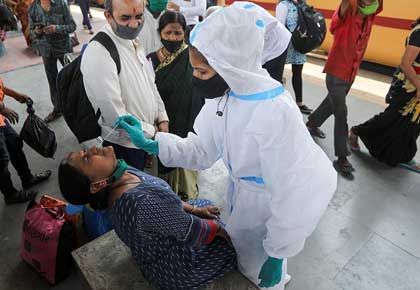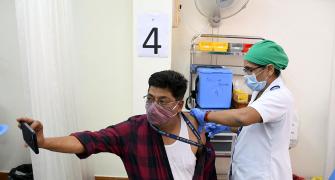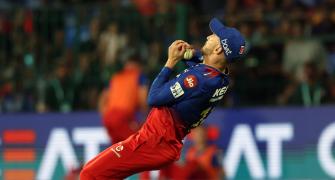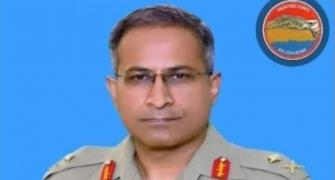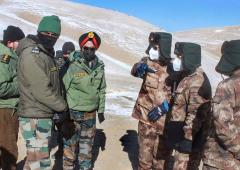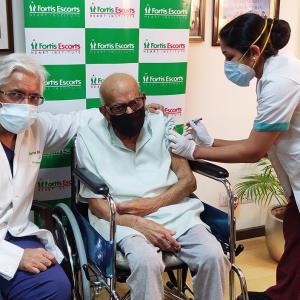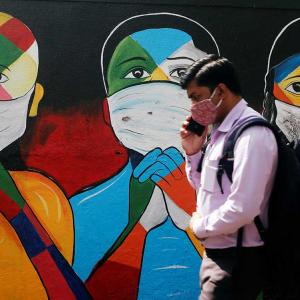'But to see the effects of that, it will take a week or two more.'
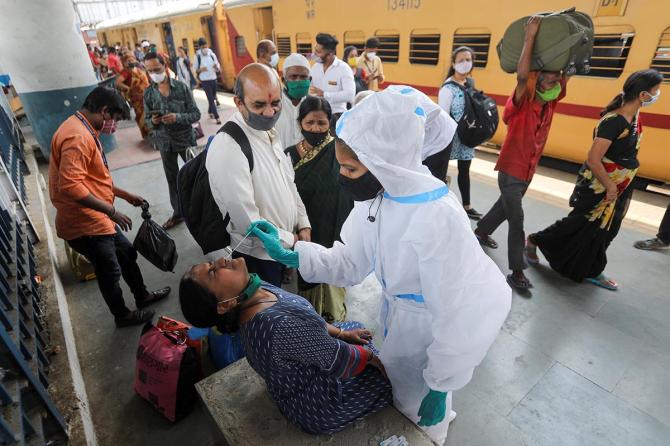
"It's a very, very steep mountain to even attempt to climb," says Dr Rahul Pandit, reflectively, about COVID-19 and its seemingly never-ending peaks, in an interview with Vaihayasi Pande Daniel/Rediff.com.
"But then everywhere in the world this is happening. It's not unique for Mumbai."
A critical care specialist at Fortis Hospitals, Mumbai, Dr Pandit has been doggedly, relentlessly fighting SARS-CoV-2, the virus that has caused this freakish pandemic, since last year.
He was temporarily felled by it and admitted in critical shape to his own hospital's ICU.
The doctor recovered, grew his strength and soldiers on, working all hours seven days a week, having taken just three days off in the last year.
"There are some days where even 24 hours are less, I feel," he states matter-of-factly, soberly, without dwelling on heroics.
It's tiring.
Very tiring, agrees Dr Pandit, especially as Mumbai and Maharashtra is again struggling at the top of summit of COVID-19 cases.
"But where do we go? We have to put our chins up and keep looking after our patients."
The present situation in Mumbai and Maharashtra -- as the megapolis registers 2,000 plus new cases per day and the state 15,000 per day -- is not that perturbing, feels Dr Pandit cautiously.
There is work to be done.
Lots of it.
To once again, gain control of wily COVID-19, but there several silver linings too, believes Dr Pandit.
The Fortis director of critical care is also a member of the Maharashtra COVID-19 taskforce and advises the state government on strategy in relation to the pandemic.
Dr Pandit earned his degrees at the Grant Medical College, Mumbai, and in Australia.
He has over 20 years of experience in ICU care -- his most valuable being this last year when he joined the fearless, tireless army of doctors across the country, and the world, fighting off, for us, an enemy, more serious and more vicious than probably any that the world has seen before.
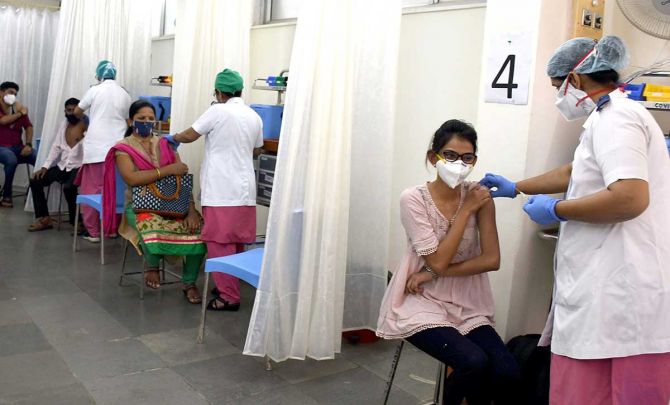
What is the situation in Mumbai?
What is the picture you are looking at like right now?
How does it compare to what you saw last year, maybe around July or mid-August, when we had 2,000 new COVID-19 cases per day, or so, too?
Certainly, there are two peaks -- if we are going to compare the numbers which we have now, which are close to 2,000 new cases per day, with the numbers we had in June, July, August, when we were around 2,000 for a long time too.
The big difference: The number of asymptomatic patients this time around.
A large number of patients are actually asymptomatic.
The second aspect: We also don't have so many critical patients, fortunately.
We have a number of patients, who are moderately sick, or mildly sick, but the ventilated patients are only few.
If you were to have visited my ICU (at Mulund, northeast Mumbai) in the month of April or May, last year, I had several patients on a ventilator, which is not the case now.
Many more of the patients are actually on just oxygen or high-flow nasal cannula*.
And they seem to do well.
Only a couple of ventilated patients every day.
That's the big difference, which I'm seeing -- the criticality has definitely have come down.
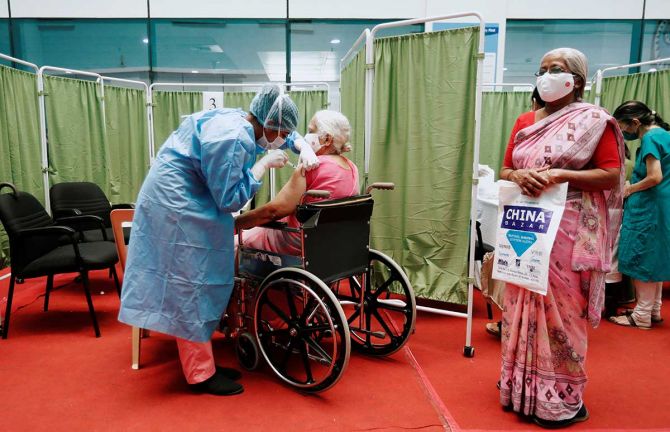
The people who are asymptomatic, they won't be stepping into your hospital.
What is your interaction with these asymptomatic COVID-19 sufferers?
Are you seeing the more serious patients, who have contracted COVID-19 from asymptomatic people?
No, no.
If there were more patients who were symptomatic, they would be step into my hospital.
We would have hospitals full, the smaller hospitals too and people back into COVID-19 care, which is not the case right now.
Most of the hospitals actually have several beds which are vacant, at least the ICU beds.
Ward beds may not be necessarily vacant.
But they don't have anything to do with the criticality.
Overall, I think, the numbers are low, in terms of the critical patients and the moderately sick patients.
Yes, tests are positive and numbers are there -- 2,000 people (new cases per day) are there.
But last year, when cases were at 2,000 new people per day, hospitals were full to the brim.
You are saying numbers are going up, but they are not showing up in your hospital, which means most of them don't need hospitalisation?
Correct, most of them don't need hospitalisation.
Most of them have got no symptoms or very mild symptoms.
One has seen various articles/data that indicate that the mortality in Maharashtra is very high, compared to the national average.
If the mortality in Maharashtra is high then you will be seeing them in your hospital?
The overall mortality in Maharashtra for the whole pandemic is higher than the rest of the country -- that's because in the first few months, mortality was very high in Maharashtra.
But now the mortality is down.
We are recording like 50 deaths for around 19,000 people positive.
If you look at that percentage-wise, it is around 2 per cent or so.
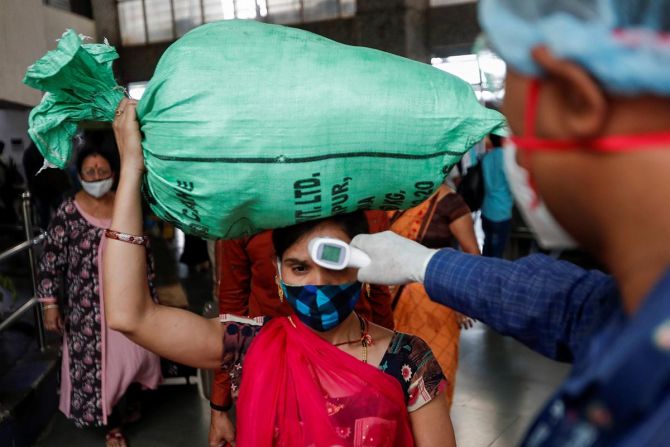
But that's higher than the rest of India?
Correct.
That's much higher than the rest of India, but that is much better for Maharashtra than what it was before.
You have to compare Maharashtra to Maharashtra.
I can't compare Maharashtra suddenly to Delhi.
So, you are saying a higher mortality has been Maharashtra's problem right from the beginning?
Yes.
And now the Mumbai mortality in fact has come down below 0.5 per cent and Maharashtra mortality is also creeping down every day.
Every day we are we are going down.
Right now, for 2,000 cases in Mumbai, we have only four deaths or five deaths reported.
The numbers have really improved now.
Overall in Maharashtra, if you look at 15,000 people testing positive, then the number of deaths is 50.
Again, the number is now below 1 per cent.
For the last month or so the numbers have really come down, but, yes, to average it out, it's going to take time.
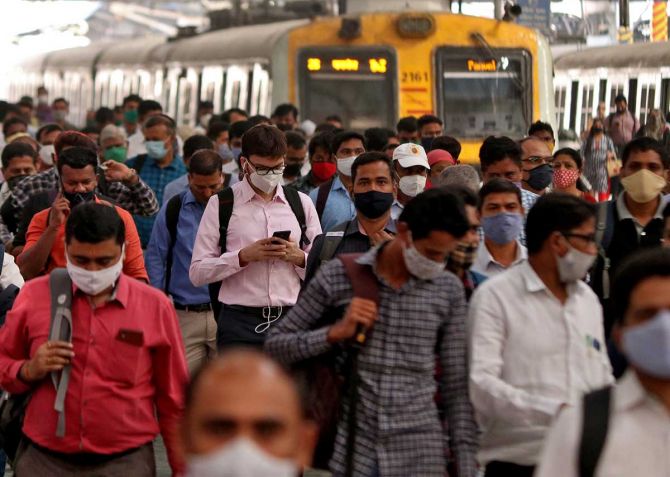
It's pretty hard to sort out the terms one is hearing -- if it is a second wave, then what exactly does a second wave mean?
Is it a second peak because the public's guard against COVID-19 is down?
But it could also be because there are new variants/ mutations around that are bolstering the numbers.
Is that what this second wave means?
A second wave means a combination of all of these factors -- guard is down, the testing may have been a bit low.
The mutant strains may have had something to do with it.
And the economy would have opened up and there will be no restrictions on people movement, so hence the second wave happens.
There could be a third wave.
Or a fourth wave too.
But these next waves -- a second wave is when a combination of factors lead to the case load shooting up?
Correct, correct.
Doctors and epidemiologists tell you, that all over India, we are pretty good at fighting back when COVID-19 cases start going up.
Is the fightback already happening in Maharashtra?
Yes, Maharashtra is putting up a fight.
But to see the effects of that, it will take a week or two more.
What are you seeing that you would call a fightback?
The first thing, what we need to do, is to go back to the drawing board, which is what we have done.
You start testing -- behind every single positive, you start tracing the 20 to 30 people, who are close contacts.
You isolate them, and you test them.
That's how you increase your testing.
And then try and bring the test positivity rate below 5 per cent.
The third thing to do: Test as much as you can, so that RT-PCR test** (Reverse transcription polymerase chain reaction test) are the majority of your tests, and antigen test** should be less in number.
The ratio should be around 70:30 or 70 per cent tests should be RT-PCR and 30 per cent antigen tests.
And as soon as you identify a positive patient, you isolate them at home for a home quarantine.
But if you feel that this patient/person is not going to do it (isolate) in the true spirit of a home quarantine then you action institutional quarantine for them.
You agreed that our fight back is always good. But it always takes a little bit of time to get things mobilised and see evidence of the fightback?
Yes.

In your view, when was the first sign of the red flag going up vis-a-vis rising COVID-19 cases in Mumbai and Maharashtra?
Was it at the end of January?
Around the first week of February, second week of February.
We thought that the cases were rising and the fight back is not happening for the last two- and-a-half, three weeks.
It usually takes a month or so before you start seeing the effects (of the fight back).
I think about three weeks almost have gone by.
We should see it in a week or two.
But if we look back at last year, cases started going up, up, up in June in Mumbai and India.
They went really high in July-August.
And in mid-September, they started coming down.
It took about three months to come down.
Will it take less time, this time, to come down because we are more familiar with the disease and the situation?
We are more prepared, so it should take less time.
How long more do you think the situation will be critical for?
I don't know, honestly.
But it won't take three months.
Maybe half of that?
Yeah, yeah.
But I am able to say it should take maybe half of that time.
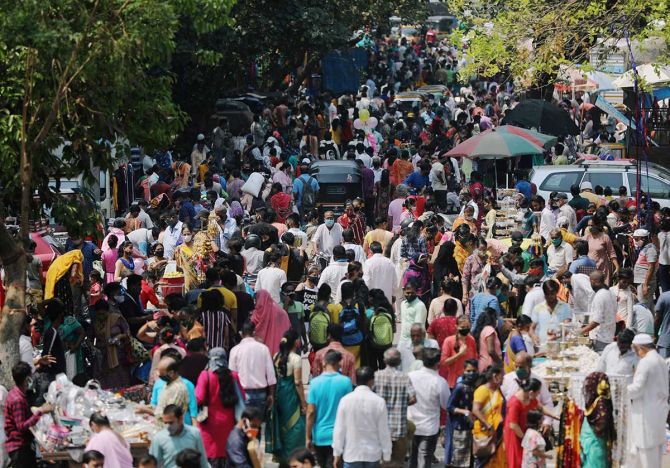
But are you worried that it's a little bit out of control?
I have been away from Mumbai in the interim and when one looks at the streets it is a bit scary.
The scene looks like COVID-19 has been forgotten in Mumbai.
Do you feel it's a little bit out of control?
The COVID-appropriate behaviour was out of control completely.
It is crawling back in.
It has not leaped back in -- it is crawling back in.
At least in the cities, if you look, people, in the last two weeks, have been a bit more cautious about COVID-appropriate behaviour.
They are following it.
But had you been here in January, all across the country, there was no masking among the general people, you know.
They were just moving around.
So that has been the single-most important factor for things to actually worsen.

Pandemic fatigue has been around now for quite some time.
Last year, when one spoke to the folks one knew, you heard that everybody was celebrating Diwali big time.
People were also doing all kinds of things that they should not have been doing.
But why has it sort of come to a head only now?
And why in Maharashtra specifically?
I don't have the answer for your second question ie why Maharashtra specifically.
But certainly, I think it was a culmination of lockdown opening up; schools, colleges, locals opening up; and COVID-appropriate behavior going down.
A lot of super spreader events, like weddings, parties, going out for picnics, which started happening, which led to this.
Somewhere it spurted and then it sort of became this whole big thing.
So, step by step by step by step and then boom?
I think so.
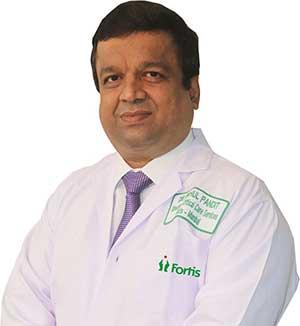 IMAGE: Dr Rahul Pandit.
IMAGE: Dr Rahul Pandit.There is a lot of talk about the Vidarbha (eastern Maharashtra) variant and what's happening in Amravati (also eastern Maharashtra).
The COVID-19 virus is spreading amongst such a large number of people, so there are going to be so many variants.
What are the variants you're seeing, or have heard of, or have encountered?
There is a view that the London variant is already here somewhere in Maharashtra.
And talk about this more contagious E484Q.
From the medical point of view, what is the real story?
There is no confirmation of any of these strains from the National Institute of Virology (Pune).
Clinically, what I can see is that there must be some strains, but probably not the true London strain, otherwise we would have had so many cases and (numbers) as bad as what London/the UK had and is having right now.
What's most important, whatever the strain, there are more asymptomatic patients.
There is definitely something there which have made the strain a little less infectious, a little less virulent, than what it was before.
So, the second wave is about our guard being down.
And about variants, but not necessarily as bad variants as the South Africa, Brazil and London variants?
Correct.
That's right.
I think this must be a homegrown variant, likely, if at all there is a variant, of consequence.
Do you think that some of the London variant has popped up here?
It would be naive to think not.
There's so much traffic between Mumbai and the United Kingdom in general -- it's naïve to think that nobody came through.
But it has probably not created the same effect that it created in the UK.
But why haven't the various more critical variants been identified?
As a layperson, I don't understand why labs are not identifying it, if it's there.
For this genome there are 900 samples which are being sent across to NIV.
They are waiting for the report.
They are in the process of doing that.
* High-flow nasal cannula therapy is an oxygen supply system that can deliver up to 100 per cent humidified and heated oxygen at a flow rate of up to 60 l per minute.
** SARS-CoV-2 RT-PCR detects viral RNA and a positive result is highly specific for the presence of the virus.
But its accuracy depends on 'the assay (or attempt) itself but also the limit of detection, viral inoculum, timing of testing, and sample collection site' according to the Infectious Diseases Society of America.
Feature Presentation: Ashish Narsale/Rediff.com
